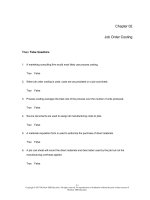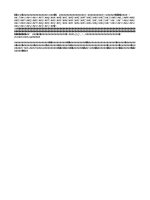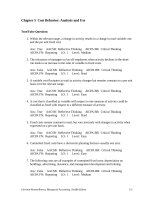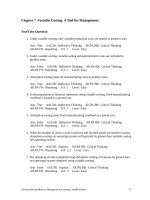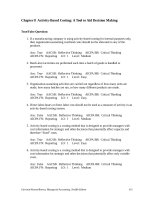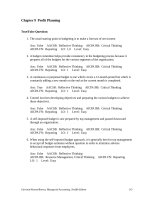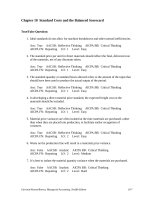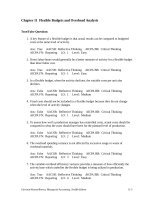Test bank managerial accounting 3rd stacey whitecotton
Bạn đang xem bản rút gọn của tài liệu. Xem và tải ngay bản đầy đủ của tài liệu tại đây (761.81 KB, 382 trang )
Chapter 01
Introduction to Managerial Accounting
True / False Questions
1. Financial accounting information is generally used exclusively by internal parties such
as managers.
True
False
2. Financial accounting information is reported for the company as a whole.
True
False
3. Managers must direct, lead and motivate during the implementation function.
True
False
4. Managers of small, private corporations use managerial accounting information
whereas managers of large, public corporations use financial accounting information.
True
False
5. The Sarbanes-Oxley Act of 2002 places full responsibility on the board of directors for
the accuracy of the reporting system.
True
False
6. The Sarbanes-Oxley Act of 2002 focuses on three factors that affect the accounting
reporting environment: ethics, fraud, and managers.
True
False
7. A sustainable business is one with the ability to meet the needs of today without
sacrificing the ability of future generations to meet their own needs.
True
False
8. An opportunity cost is the cost of not doing something.
True
False
9. Whether a cost is treated as direct or indirect depends on whether tracing the cost is
both possible and feasible.
True
False
1-1
Copyright © 2017 McGraw-Hill Education. All rights reserved. No reproduction or distribution without the prior written consent of
McGraw-Hill Education.
10. Variable costs are always direct costs.
True
False
11. Fixed costs stay the same, on a per-unit basis, as activity level changes.
True
False
12. Prime costs include direct materials, direct labor, and manufacturing overhead.
True
False
13. All manufacturing costs are treated as product costs.
True
False
14. All manufacturing costs are inventoriable costs.
True
False
15. A cost that will occur in the future and differs between various alternatives under
consideration is a relevant cost.
True
False
Multiple Choice Questions
16. What is the primary goal of accounting?
A.
B.
C.
D.
To set long-term goals and objectives.
To arrange for the necessary resources to achieve a plan.
To provide information for decision making.
To motivate others to work towards a plan's success.
17. Of the following groups, which is the primary user of managerial accounting
information?
A.
B.
C.
D.
1-2
Copyright © 2017 McGraw-Hill Education. All rights reserved. No reproduction or distribution without the prior written consent of
McGraw-Hill Education.
18. Managerial accounting, as compared to financial accounting, is primarily intended to
facilitate:
A.
B.
C.
D.
an understanding of GAAP.
making decisions with timely, relevant information.
conducting ethics investigations under SOX.
reporting results to shareholders.
19. Managerial accounting information includes all of the following except:
A.
B.
C.
D.
Performance evaluations, for example budget-to-actual reports.
Financial statements prepared in accordance with generally accepted accounting
20. Which of the following is not a characteristic of financial accounting?
A.
B.
C.
D.
Financial reports are prepared according to GAAP.
Information is used by external parties.
Information is subjective, relevant and future-oriented.
Reports are prepared periodically.
21. Which of the following is not a characteristic of financial accounting?
A.
B.
C.
D.
Information is reported at the decision making level.
Information is used by external parties.
Information is objective, reliable and historical.
Reports are prepared periodically.
22. Which of the following is not a characteristic of financial accounting?
A.
B.
C.
D.
Financial reports are prepared according to GAAP.
Information is used primarily by internal parties.
Information is objective, reliable and historical.
Reports are prepared periodically.
23. Which of the following is not a characteristic of managerial accounting?
A.
B.
C.
D.
Information is used by internal parties.
Information is subjective, relevant, future-oriented.
Reports are prepared as needed.
Reports are prepared according to GAAP.
1-3
Copyright © 2017 McGraw-Hill Education. All rights reserved. No reproduction or distribution without the prior written consent of
McGraw-Hill Education.
24. Which of the following is not a characteristic of managerial accounting?
A.
B.
C.
D.
Information is used by external parties.
Information is subjective, relevant, future-oriented.
Reports are prepared as needed.
Information is reported at the decision making level.
25. Which of the following is not a characteristic of managerial accounting?
A.
B.
C.
D.
Information is used by internal parties.
Information is subjective, relevant, future-oriented.
Reports are prepared as needed.
Information is reported for the company as a whole.
26. Which of the following types of reports is more characteristic of managerial
accounting than financial accounting?
A.
B.
C.
D.
An internal report used by management
An external report used by investors
A report prepared according to GAAP
A report prepared periodically (monthly, quarterly, annually)
27. The control function is:
A.
B.
C.
D.
Comparing actual with budgeted results and taking corrective action when need
Arranging of the necessary resources to carry out the plan.
The directing, leading, and motivating of those necessary to carry out the pla
Drafting the goals and strategies to achieve long-term results.
28. During the last fiscal year, XYZ organization implemented managerial accounting to
allocate program costs to its soup kitchen. The kitchen's manager is reviewing actual
results from the prior month to compare the outcomes with the organization's
objectives. Which function of the Plan-Implement-Control cycle is she conducting?
A.
B.
C.
D.
29. Which of the following types of organizations purchases raw materials from suppliers
and uses them to create a finished product?
A.
B.
C.
D.
Manufacturing firms
Merchandising companies
Service compa
1-4
Copyright © 2017 McGraw-Hill Education. All rights reserved. No reproduction or distribution without the prior written consent of
McGraw-Hill Education.
30. Hair salons and law firms are examples of which of the following type of
organization?
A.
B.
C.
D.
Service companies
Manufacturing firm
Merchandising companies
31. Which of the following types of organizations sells goods to the general public?
A.
B.
C.
D.
Service companies
Manufacturing firms
Merchandising companies
32. Which of the following statements is true about the use of managerial accounting
information in nonprofit organizations?
A.
B.
C.
D.
Universities do not exist strictly to earn profit for shareholders, so managerial acco
Unlike other nonprofits, hospitals (which exist with a focus on financial results in a
Because managers of nonprofit organizations need timely and relevant informatio
Because nonprofit organizations - hospitals, educational institutions, charities - do
33. Which of the following functions of management involves comparing actual results
with budgeted results?
A.
B.
C.
D.
34. Which of the following functions of management involves setting short and long-term
objectives and the tactics to achieve them?
A.
B.
C.
D.
35. Which of the following functions of management involves arranging the necessary
resources to carry out the plan?
A.
B.
C.
D.
1-5
Copyright © 2017 McGraw-Hill Education. All rights reserved. No reproduction or distribution without the prior written consent of
McGraw-Hill Education.
36. Which of the following functions of management involves providing motivation to
achieve results?
A.
B.
C.
D.
37. Which of the following functions of management involves taking corrective action if
needed?
A.
B.
C.
D.
38. Which of the following functions of management involves providing feedback for
future plans?
A.
B.
C.
D.
39. Which of the following is the correct sequencing of the functions within the
managerial cycle?
A.
B.
C.
D.
Plan - Control - Implement
Review - Plan - Implement
Plan - Implement - Control
Review - Control - Plan
40. Which of the following describes the Planning function within the management
cycle?
A.
B.
C.
D.
Setting short and long-term objectives
Comparing actual to budgeted results and taking corrective action
Taking actions to implement the plan
Arranging the necessary resources to carry out the plan
41. Which of the following describes the Control function within the management cycle?
A.
B.
C.
D.
Setting short and long-term objectives
Comparing actual to budgeted results and taking corrective action
Taking actions to implement the plan
Arranging the necessary resources to carry out the plan
1-6
Copyright © 2017 McGraw-Hill Education. All rights reserved. No reproduction or distribution without the prior written consent of
McGraw-Hill Education.
42. Which of the following does not describe the Implementing function within the
management cycle?
A.
B.
C.
D.
Leading, directing, and motivating others to achieve the plan's goals
Arranging the necessary resources to carry out the plan
Taking actions to implement the plan
Setting short- and long-term objectives
43. "Ethics" refers to all of the following except:
A.
B.
C.
D.
The standards of conduct for judging fair from unfair.
The standards of conduct for judging right from wrong.
The standards of conduct for judging opportunity from incentives.
The standards of conduct for judging honest from dishonest.
44. Which of the following is not one of the factors affecting the accounting reporting
environment focused on by the Sarbanes-Oxley Act?
A.
B.
C.
D.
45. Which of the following is a requirement under the Sarbanes-Oxley Act?
A.
B.
C.
D.
Financial statements must be audited by a Big Four accounting firm.
Management must issue a report that indicates whether the financial statements a
Management must conduct a review of the company's internal control system
Background checks must be performed on all employees.
46. Which of the following is not a provision of the Sarbanes-Oxley Act?
A.
B.
C.
D.
Executives can avoid penalties for fraud by declaring personal bankruptcy.
Stiffer penalties for fraud in terms of monetary fines and jail time decrease the inc
Public companies must adopt a code of ethics for senior financial officers.
Management must issue a report that indicates whether internal controls are effe
47. Which of the following is not true about how the Sarbanes-Oxley Act counteracts
incentives for committing fraud?
A.
B.
C.
D.
It provides for stiffer monetary penalties.
It increases the maximum jail sentence for fraudulent reporting.
It removes legal protection from whistleblowers.
It provides that violators must repay any money obtained via fraud and pay fin
1-7
Copyright © 2017 McGraw-Hill Education. All rights reserved. No reproduction or distribution without the prior written consent of
McGraw-Hill Education.
48. The requirement of the Sarbanes-Oxley Act that requires management to issue a
report on internal controls places responsibility for the accuracy of the reporting
system on:
A.
B.
C.
D.
accounting managers.
marketing managers.
production managers.
49. Which of the following changes introduced by the Sarbanes-Oxley Act is not one
intended to reduce opportunities for error and fraud?
A.
B.
C.
D.
Internal control report from management
Stronger oversight by directors
Internal control audit by external auditors
50. Which of the following changes introduced by the Sarbanes-Oxley Act is not one
intended to encourage good character?
A.
B.
C.
D.
Anonymous tip lines
Whistle-blower protection
Stiffer fines and prison terms
51. Which of the following changes introduced by the Sarbanes-Oxley Act is intended to
counteract incentives for fraud?
A.
B.
C.
D.
Stronger oversight by directors
Stiffer fines and prison terms
Anonymous tip line
52. Which of the following is not true about how the Sarbanes-Oxley Act emphasizes the
importance of the character of managers and employees?
A.
B.
C.
D.
It requires that ethics be embedded in the organizational culture.
It requires that audit committees establish anonymous tip lines.
It provides protection for whistle-blowers.
It requires that public companies adopt a code of ethics for senior financial offi
1-8
Copyright © 2017 McGraw-Hill Education. All rights reserved. No reproduction or distribution without the prior written consent of
McGraw-Hill Education.
53. Which of the following statements is correct about sustainability accounting?
A.
B.
C.
D.
Sustainability accounting has been in existence since 1592.
Sustainability accounting tracks a company's "green" score.
Sustainability accounting aims to provide managers a broad set of information to
Sustainability accounting is a subset of GAAP applied only to socially responsible
54. Which of the following statements is correct about the triple bottom line?
A.
B.
C.
D.
The triple bottom line measures a company's social impact, without regard for p
The triple bottom line captures three factors: People, Profit, and Planet.
The triple bottom line has replaced net income as the most crucial measure of a c
The triple bottom line reports profit at the expense of social factors.
55. Many organizations are building sustainable business practices into their strategies,
including by issuing:
A.
B.
C.
D.
Corporate social responsibility reports.
Reports on internal controls.
Profit and loss statements that reflect people and planet costs.
Reports from the board of directors on sustainability.
56. An out-of-pocket costs is:
A.
B.
C.
D.
an actual outlay of cash.
the cost of not doing something.
a budgeted estimate.
57. Which of the following is not one of the categories used to sort costs in managerial
accounting?
A.
B.
C.
D.
Relevant or irrelevant
Out-of-pocket or opportunity
58. Which of the following statements concerning costs is incorrect?
A.
B.
C.
D.
Costs are treated differently depending on how the information will be used.
Out-of-pocket costs include the costs associated with not taking a particular cours
Any single cost can be classified in more than one way.
Costs can be categorized on the basis of relevant or irrelevant costs.
1-9
Copyright © 2017 McGraw-Hill Education. All rights reserved. No reproduction or distribution without the prior written consent of
McGraw-Hill Education.
59. The cost of not doing something is a(n):
A.
B.
C.
D.
out-of-pocket co
60. An actual outlay of cash is a(n):
A.
B.
C.
D.
out-of-pocket co
61. An opportunity cost is:
A.
B.
C.
D.
the foregone benefit of the path not taken.
an actual outlay of cash.
the initial investment required to pursue an opportunity.
a cost that cannot be traced to a specific cost object.
62. An out-of-pocket cost involves which of the following?
A.
B.
C.
D.
Choosing to do one thing instead of another.
Tracing the cost directly to a cost object.
An actual outlay of cash.
Determining how the cost changes with a change in activity level.
63. To earn summer money, Joe could mow lawns in his neighborhood, or he could work
at a local grocery store. Which of the following is an opportunity cost of mowing
lawns?
A.
B.
C.
D.
Cash paid for gas to run the lawnmower.
The time spent mowing the lawns.
The wages he could have earned working at the grocery store.
Depreciation on the lawnmower.
64. To earn summer money, Joe could mow lawns in his neighborhood, or he could work
at a local grocery store. Which of the following is an out-of-pocket cost of mowing
lawns?
A.
B.
C.
D.
The use of his father's truck to get to job sites.
The wages he could have earned working at the grocery store.
The time spent mowing the lawns.
Cash paid for gas to run the lawnmower.
1-10
Copyright © 2017 McGraw-Hill Education. All rights reserved. No reproduction or distribution without the prior written consent of
McGraw-Hill Education.
65. Which of the following cannot be an out-of-pocket cost?
A.
B.
C.
D.
An opportunity cost.
66. Costs that can be traced to a specific cost object are:
A.
B.
C.
D.
67. Costs that are not worth the effort to trace to a specific cost object are:
A.
B.
C.
D.
68. Which of the following statements is correct?
A.
B.
C.
D.
A direct cost can be readily traced to a cost object while an indirect cost is traced
An indirect cost can be readily traced to a cost object while a direct cost is traced
A direct cost can be traced to a specific cost object, while an indirect cost cann
An indirect cost can be traced to a specific cost object, while a direct cost cann
69. A direct cost is one that:
A.
B.
C.
D.
involves an actual outlay of cash for a specific cost object.
can be traced to a specific cost object.
cannot be traced to a specific cost object.
is not worth the effort of tracing to a specific cost object.
70. What determines the difference between a direct and an indirect cost?
A.
B.
C.
D.
Whether it changes when activity levels change.
Whether it is relevant to a particular decision.
Whether it can be traced to a specific cost object.
Whether it is related to manufacturing or nonmanufacturing activities.
1-11
Copyright © 2017 McGraw-Hill Education. All rights reserved. No reproduction or distribution without the prior written consent of
McGraw-Hill Education.
71. Which of the following is an indirect cost of manufacturing a table made of wood and
glass for a firm that manufactures furniture?
A.
B.
C.
D.
The cost of the wood in the table.
The cost of the labor used to assemble the table.
The cost of the glass in the table.
The cost of rent on the factory where the table is manufactured.
72. Which of the following is a direct cost of manufacturing a table made of wood and
glass, for a firm that manufactures furniture?
A.
B.
C.
D.
The cost of the wood in the table.
The cost of rent on the factory where the table is manufactured.
The salary of the supervisor who oversees all production for the firm.
Depreciation on the tools used to manufacture the table.
73. A cost object is:
A.
B.
C.
D.
an item for which managers are trying to determine the cost.
an item to which managers must directly trace costs.
an item to which it is not worth the effort of tracing costs.
an item for sale by a business.
74. Indirect costs are:
A.
B.
C.
D.
costs that are not worth the effort to trace to a specific cost object.
costs that change, in total, in direct proportion to changes in activity levels.
costs that remain constant no matter the activity level.
75. Variable costs are:
A.
B.
C.
D.
costs that are not worth the effort to trace to a specific cost object.
costs that change, in total, in direct proportion to changes in activity levels.
costs that remain constant no matter the activity level.
76. A cost is $50,000 when 25,000 units are produced, and $100,000 when 50,000 units
are produced. This is an example of a(n):
A.
B.
C.
D.
1-12
Copyright © 2017 McGraw-Hill Education. All rights reserved. No reproduction or distribution without the prior written consent of
McGraw-Hill Education.
77. A cost is $50,000 when 25,000 units are produced, and $50,000 when 50,000 units
are produced. This is an example of a(n):
A.
B.
C.
D.
78. What determines the difference between a variable and a fixed cost?
A.
B.
C.
D.
Whether the total cost changes when activity levels change.
Whether the total cost is relevant to a particular decision.
Whether the total cost can be traced to a specific cost object.
Whether the total cost is related to manufacturing or nonmanufacturing activi
79. Which of the following is an example of a variable cost for a manufacturing firm?
A.
B.
C.
D.
The cost of rent on the factory.
The cost of factory supervision.
The cost of raw materials.
The cost of depreciation on equipment.
80. Fixed costs are:
A.
B.
C.
D.
costs that are not worth the effort to trace to a specific cost object.
costs that change, in total, in direct proportion to changes in activity levels.
costs that remain constant, in total, no matter the activity level.
81. A fixed cost:
A.
B.
C.
D.
goes up in total when activity increases.
goes up per unit when activity increases.
goes down in total when activity increases.
goes down per unit when activity increases.
82. A relevant cost is a cost that:
A.
B.
C.
D.
has the potential to influence a decision.
changes in direct proportion to changes in activity level.
can be traced to a specific cost object.
is used for control purposes.
1-13
Copyright © 2017 McGraw-Hill Education. All rights reserved. No reproduction or distribution without the prior written consent of
McGraw-Hill Education.
83. An irrelevant cost:
A.
B.
C.
D.
is also called a differential cost.
must differ between decision alternatives.
must be incurred in the future rather than in the past.
will not influence a decision.
84. For a cost to be relevant, it must:
A.
B.
C.
D.
differ between decision alternatives.
have already been incurred.
not influence a decision.
not be a differential cost.
85. A cost that has already been incurred is called a(n) _______________ cost.
A.
B.
C.
D.
86. You are to receive five gold coins from your great uncle as an incentive to study hard.
The coins were originally purchased in 1982. Your great uncle will deliver the coins
the week after finals (assuming your grades are "acceptable"). The amount your
great uncle paid for the coins is a(n):
A.
B.
C.
D.
87. For a cost to be relevant, it must meet which of the following criteria?
A.
B.
C.
D.
It must not differ between the decision alternatives and it must be incurred in the
It must differ between the decision alternatives and it must be incurred in the futu
It must not differ between the decision alternatives and it must have occurred in
It must differ between the decision alternatives and it must have occurred in the
88. For a cost to be relevant, it must be:
A.
B.
C.
D.
a differential cost and a sunk cost.
a differential cost, but not a sunk cost.
a sunk cost, but not a differential cost.
neither a differential cost nor a sunk cost.
1-14
Copyright © 2017 McGraw-Hill Education. All rights reserved. No reproduction or distribution without the prior written consent of
McGraw-Hill Education.
89. Which of the following costs is not relevant to the decision whether to replace an old
computer with a new one?
A.
B.
C.
D.
The cost of the new computer.
The cost of the old computer.
The cost of a service plan on the new computer.
The cost to repair the old computer if a new computer is not purchased.
90. Manufacturing costs are generally classified into which of the following categories?
A.
B.
C.
D.
Relevant costs and irrelevant costs
Direct materials, direct labor, and manufacturing overhead
Prime costs and conversion costs
Conversion costs, marketing costs, and administrative costs
91. Prime costs are defined as:
A.
B.
C.
D.
manufacturing costs plus non-manufacturing costs.
direct labor plus direct materials.
variable costs equal fixed costs.
manufacturing overhead plus direct labor.
92. Which of the following is not a manufacturing cost?
A.
B.
C.
D.
Raw materials cost.
Manufacturing overhead cost.
93. Nonmanufacturing costs are generally classified into what two groups?
A.
B.
C.
D.
Conversion costs and prime costs.
Direct materials and direct labor.
Marketing costs and administrative costs.
Direct labor and manufacturing overhead.
1-15
Copyright © 2017 McGraw-Hill Education. All rights reserved. No reproduction or distribution without the prior written consent of
McGraw-Hill Education.
94. Robin Company has the following balances for the current month:
Direct materials used
$24,000
Direct labor
$36,800
Sales salaries
$19,200
Indirect labor
$4,800
Production manager’s salary
$9,600
Marketing costs
$14,400
Factory lease
$6,400
What are Robin's prime costs?
A.
B.
C.
D.
95. Conversion costs can be defined as:
A.
B.
C.
D.
manufacturing costs plus non-manufacturing costs.
direct labor plus direct materials.
variable costs plus fixed costs.
manufacturing costs minus direct materials.
96. Manufacturing costs are:
A.
B.
C.
D.
the costs incurred to produce a final product.
split into prime costs and conversion costs.
97. Prime costs are the same as:
A.
B.
C.
D.
manufacturing costs minus non-manufacturing costs.
manufacturing costs minus manufacturing overhead.
manufacturing costs minus fixed costs.
manufacturing costs minus direct materials.
1-16
Copyright © 2017 McGraw-Hill Education. All rights reserved. No reproduction or distribution without the prior written consent of
McGraw-Hill Education.
98. Robin Company has the following balances for the current month:
Direct materials used
$24,000
Direct labor
$36,800
Sales salaries
$19,200
Indirect labor
$4,800
Production manager’s salary
$9,600
Marketing costs
Factory lease
$14,400
$6,400
What is Robin's total manufacturing cost?
A.
B.
C.
D.
99. Robin Company has the following balances for the current month:
Direct materials used
$24,000
Direct labor
$36,800
Sales salaries
$19,200
Indirect labor
$4,800
Production manager’s salary
Marketing costs
Factory lease
$9,600
$14,400
$6,400
What is Robin's total manufacturing overhead?
A.
B.
C.
D.
1-17
Copyright © 2017 McGraw-Hill Education. All rights reserved. No reproduction or distribution without the prior written consent of
McGraw-Hill Education.
100 Robin Company has the following balances for the current month:
.
Direct materials used
$24,000
Direct labor
$36,800
Sales salaries
$19,200
Indirect labor
$4,800
Production manager’s salary
$9,600
Marketing costs
$14,400
Factory lease
$6,400
What are Robin's conversion costs?
A.
B.
C.
D.
101 GAAP reporting rules require that all manufacturing costs be treated as:
.
A.
B.
C.
D.
102 Product costs are sometimes called:
.
A.
B.
C.
D.
inventoriable co
103 Which of the following is true about product and period costs?
.
A.
B.
C.
D.
Product costs are usually manufacturing costs, and period costs are usually nonm
Product costs are usually nonmanufacturing costs, and period costs are usually m
Both product and period costs are usually manufacturing costs.
Both product and period costs are usually nonmanufacturing costs.
104 Product costs are:
.
A.
B.
C.
D.
expensed on the income statement when incurred.
treated as an asset and depreciated.
inventoried until the units are sold.
considered current liabilities until paid.
1-18
Copyright © 2017 McGraw-Hill Education. All rights reserved. No reproduction or distribution without the prior written consent of
McGraw-Hill Education.
105 When are period costs counted as inventory?
.
A.
B.
C.
D.
Before products are sold.
After products are sold.
After products are completed, but before they are sold.
106 What determines the difference between a product cost and a period cost?
.
A.
B.
C.
D.
Whether the cost changes when activity levels change.
Whether the cost is relevant to a particular decision.
Whether the cost can be traced to a specific cost object.
When the cost will be matched against revenue on the income statement.
107 Product costs are reported:
.
A.
B.
C.
D.
only on the balance sheet.
only on the income statement.
on the balance sheet before goods are sold, and on the income statement after g
on the income statement before goods are sold, and on the balance sheet after g
108 Which of the following might you find in a job description for a managerial
.
accountant in a manufacturing company?
A.
B.
C.
D.
The Managerial Accountant will conduct internal analysis on the health of the com
The Managerial Accountant will be the primary contact in dealing with the externa
The Managerial Accountant will be responsible for preparing and presenting quar
The ideal candidate for this position will have a strong knowledge of financial acc
109 Pretend you are the president of the Managerial Accounting Club and you are
.
responsible for executing the club's most important event: A recruiting event for
members and local firms. How might you use the Plan-Implement-Control cycle?
A.
B.
C.
D.
To plan, I would prepare a preliminary list of goals and plans and then hold a kickTo control, I would identify two additional individuals within the club to help lead
To control, I would create a timeline and schedule of key tasks leading up to the e
To implement, I would hold regular check-in meetings to monitor progress.
1-19
Copyright © 2017 McGraw-Hill Education. All rights reserved. No reproduction or distribution without the prior written consent of
McGraw-Hill Education.
110 Pretend you are a junior managerial accountant. Your supervisor has no knowledge of
.
sustainability accounting. All of the following statements would be convincing
arguments to advocate for the importance of sustainability accounting, except one.
Which one?
A.
B.
C.
D.
Sustainability accounting reflects the changing nature of accountability.
Companies are only accountable to shareholders… And shareholders care about s
Companies are accountable to the world at large, not simply to shareholders
Sustainability accounting does not replace the emphasis on financial results; rath
111 Imagine purchasing a cup of coffee. Which of the following statements correctly
.
classifies the direct, indirect, variable, and fixed costs associated with that purchase,
assuming the cost object is the cup of coffee?
A.
B.
C.
D.
The cost of the cup and the lid is an indirect cost because it can be readily traced
The shop supervisor's salary is a direct cost because it cannot be readily and feas
The volume of coffee beans purchased is a variable cost because it changes alon
The shop's monthly water bill is a fixed cost because it changes along with the ch
Essay Questions
1-20
Copyright © 2017 McGraw-Hill Education. All rights reserved. No reproduction or distribution without the prior written consent of
McGraw-Hill Education.
112 Stetson Manufacturing builds custom wooden cabinets. Classify the following items
.
as to a) what category of product costs and b) whether the item is a prime or
conversion cost.
Product Costs
Direct Dir
Mfg
Pri Conver
Mater ect Overh me
sion
ials Lab ead Cos
Cost
or
t
Cost of
hardware
(slides,
handles,
etc.)
Cost of
wood
Depreciat
ion on
productio
n
equipmen
t
Factory
property
taxes
Factory
rent
Glue
Productio
n
superviso
r salary
Utilities
for
factory
Wages for
maintena
nce
workers
Wages of
assembly
workers
Wages of
finishing
workers
1-21
Copyright © 2017 McGraw-Hill Education. All rights reserved. No reproduction or distribution without the prior written consent of
McGraw-Hill Education.
113 For each of the following independent cases, compute the missing values:
.
Case
Prime
Cost
A
$13,600
Conversio
Direct
n Cost
Materials
Used
Direct
Labor
Manufacturin
Total
g Overhead Manufacturin
g Cost
$23,000
$4,600
??
$14,000
??
B
??
??
$6,000
$3,000
$10,500
??
C
$23,000
$41,000
$7,000
??
??
??
D
??
$23,550
$4,200
$9,750
??
$27,750
E
??
??
??
$6,300
$9,300
$17,400
1-22
Copyright © 2017 McGraw-Hill Education. All rights reserved. No reproduction or distribution without the prior written consent of
McGraw-Hill Education.
114 Quail Company builds snowboards. Quail Company has reported the following costs
.
for the previous year. Assume no production inventories.
Cost of fiberglass (raw material)
Factory rent
Advertising
Utilities for factory
Wages of assembly workers
$119,000
$67,200
$175,000
$25,200
$126,000
Production supervisor salary
$63,000
Sales manager salary
$58,800
Factory property taxes
$16,800
Depreciation on production
equipment
$35,000
Cost of bindings (raw material)
$35,000
Screws
Wages of snowboard painters
Wages for maintenance workers
$1,680
$105,000
$53,200
Compute the following:
a. Direct material costs
b. Direct labor cost
c. Manufacturing overhead
d. Total manufacturing cost
e. Prime cost
f. Conversion cost
g. Total period cost
1-23
Copyright © 2017 McGraw-Hill Education. All rights reserved. No reproduction or distribution without the prior written consent of
McGraw-Hill Education.
115 For each of the following independent cases, compute the missing values:
.
Ca Pri Conv Dire Dire Manufa Total
se me ersio
ct
ct cturing Manufa
Cos
n
Mat Lab Overhe cturing
t
Cost erial or
ad
Cost
s
Use
d
A $27, $46,0 $9,2
200
00
00
B
??
??
$28,000
??
$12, $6,0 $21,000
000 00
??
C $46, $82,0 $14,
000
00
000
D
??
E
??
??
??
$47,1 $8,4 $19,
00
00 500
??
??
??
??
??
$55,500
$12, $18,600 $34,800
600
1-24
Copyright © 2017 McGraw-Hill Education. All rights reserved. No reproduction or distribution without the prior written consent of
McGraw-Hill Education.
116 Mariposa Manufacturing builds custom wooden cabinets. Mariposa Manufacturing has
.
reported the following costs for the previous year. Assume no production inventories.
Advertising
$70,000
Cost of hardware (slides,
handles, etc.)
$34,000
Cost of wood
$117,000
Depreciation on production
equipment
$63,000
Factory property taxes
$17,300
Factory rent
$76,000
Glue
$3,800
Production supervisor salary
$40,700
Sales manager salary
$41,600
Utilities for factory
$23,900
Wages for maintenance workers
$31,800
Wages of assembly workers
$91,400
Wages of finishing workers
$77,300
Compute the following:
a. Direct material costs
b. Direct labor cost
c. Manufacturing overhead
d. Total manufacturing cost
e. Prime cost
f. Conversion cost
g. Total period cost
1-25
Copyright © 2017 McGraw-Hill Education. All rights reserved. No reproduction or distribution without the prior written consent of
McGraw-Hill Education.

